
 |
Pascha - The Resurrection of Our Lord The Feasts of feasts, the Triumphs of triumphs, Pascha is the essence of our faith; for Christ rose from the dead, as we will rise from the dead. Pascha is expressed in the victorious hymn: “Christ is risen from the dead, trampling down death by death, and upon those in the tombs bestowing life.” The guards had sealed the tomb and had posted a watch. Suddenly the earth shook and our Lord Jesus Christ was raised from the dead by the power of His own divinity. Early in the morning, Mary Magdalene and other pious women hurried to the tomb to anoint the body of Christ. When they arrived there, they found the stone had been moved away and the tomb was empty. They ran to get the Apostles Peter and John. The rest of the myrrh-bearing women came to the grave and went inside. Instead of the Lord, they found two men in bright shining clothes who said to them: “Why seek the living among the dead? He is not here, but is risen.” In the icon, Christ is depicted with a radiant halo. The darkness of Hell is filled by the light of the Divine rays. The Savior tramples under foot the two crossed leaves of Hell’s doors that He pulled down. Below the doors in the black abyss is seen the cast down figure of Satan. Christ is shown freeing Adam and Eve’s souls. To the right and left are the Old Testament saints with the prophets at their head. Seeing the Savior descending into hell, they at once recognize Him and are pointing out to others Him of Whom they had prophesied and Whose coming they foretold. The spiritual raising of Adam is a symbol of the coming resurrection of the body, the first fruit of which was the Resurrection of Christ. The scattered keys and nails in the abyss represent the power of hell that has been destroyed. |
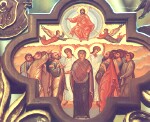 |
Ascension -- 40 Days After Pascha This great event, with which Jesus’ life on earth concludes, if briefly mentioned in the Gospels of Mark and Luke. But in the Acts of the Apostles there is a fuller account. Gathering His disciples, Jesus commanded them not to leave Jerusalem, but to await what had been promised by the Father, that is the descent of the Holy Spirit. John truly baptized with water, but you shall be baptized with the Holy Spirit not many days from now … You shall receive power when the Holy Spirit has come upon you; and you shall be witnesses to Me in Jerusalem, and in all Judea and Samaria, and to the end of the earth” Acts 1:5, 8). Saying this He went with His disciples to Bethany and stopped on the Mount of Olives. “Now when he had spoken these things, while they watched, He was taken up, and a cloud received Him out of their sight. And while they looked steadfastly toward heaven as He went up, behold, two men stood by them in white apparel, who also said, ‘Men of Galilee, why do you stand gazing up into heaven? This same Jesus, who is taken up from you into Heaven, will so come in like manner as you saw Him go into Heaven’” (Acts 1:9-11). |
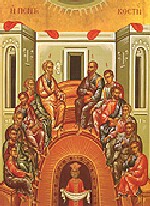 |
Pentecost -- 50 Days After Pascha The beginning of the history of the Church is the feast of Pentecost of 30 AD. On the tenth day after the Ascension of our lord Jesus Christ, His disciples, His Mother, some other holy women and some of those Jews who came to believe in Him were gathered in a home on mount Zion. As was usual, they were spending their time in prayer and in awaiting the promised Holy Spirit, when all of a sudden there was a noise from heaven as of rushing wind that filled the whole house where they were. And there appeared tongues of fire that spread out and rested on each person. And they were filled with the Holy Spirit and began to converse in other languages. There were many in Jerusalem from different lands because of the Jewish feast that commemorated the giving of the Law on Mount Sinai. They were all amazed as they heard the disciples preach the word of God in their own tongues. On that day about three thousand people were baptized in the name of our Lord Jesus Christ. Such was the beginning of the spreading of the Gospel, that through the apostles and their disciples it first spread throughout Judea, and then throughout the world. The twelve Apostles, together forming a definite figure - a semicircle - are a beautiful expression of the unity of the body of the Church. Some (the Evangelists) hold books in their hands, others scrolls, as a sign of their having received the gift of teaching. Out of the segment of the circle, the goes beyond the edge of the panel, symbolizes heaven, there descend upon them twelve rays or tongues of fire, as a sign of baptism with the Holy Spirit and with fire and a sign too of their sanctification. The multitude, mentioned in the Acts of the Apostles, is represented at the bottom of the composition. This is a symbolical figure of a King, personifying the people. |
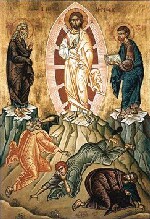 |
Transfiguration Of Our Lord - August 6 To strengthen their faith for the time when they would see Him suffering and to take their minds off earthly thoughts, Jesus Christ showed His disciples His Divine glory. Not long before His suffering, Jesus took three of His disciples - Peter, James, and John - and led them up a high mountain, Tabor, to pray. Walking a little distance from them, He began to pray while the exhausted disciples fell asleep. When they awoke, they saw their Teacher transfigured; His face shone like the sun, and His clothing was white as snow and glittering like light. And standing with Jesus were two prophets - Moses and Elijah - who appeared in their heavenly glory to talk with Jesus about how He would soon fulfill God’s purpose by suffering and dying in Jerusalem. And behold a voice out of a bright cloud said, “THIS IS MY BELOVED SON IN WHOM I AM WELL PLEASED. HEAR YE HIM! The disciples fell to the ground in fear. Jesus came near them, touched them and said: “Arise, do not be afraid.” The disciples arose and saw Jesus as He always was. When they were descending form the mountain, Jesus commanded them not to speak of what they had seen until He had risen from the dead. Christ transfigured is represented standing on the summit of the mountain, speaking with Moses and Elijah. His raiment is shining white. The geometrical figure inscribed in the circle of the mandorla must represent the “bright cloud” which revealed the transcendent source of the Divine energies. St. Peter is always shown as kneeling, supported on his left hand, and raising his right hand to protect himself from the light. St. John (always in the center) falls, turning his back to the light. St. James flees before the light or falls backwards. |
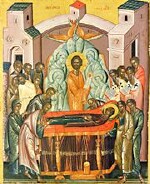 |
Dormition of the Blessed Virgin Mary - August 15 The Feast of the Dormition or Falling Asleep of the Blessed Virgin Mary commemorates the death, resurrection, and glorification of Jesus Christ's mother. The Feast of the Dormition also comes from the Tradition of the Church. There we learn that Mary died as all people die because she had a mortal human nature affected by the corruption of this world. The Church proclaims that Mary needed to be saved by Christ just as all of us are saved from trials, sufferings, and death of this world. Having truly died, she was raised by her Son as the "Mother of Life" and already participates in the eternal life of paradise which is prepared and promised to all who "hear the word of God and keep it." (Luke 11:27-28) Finally, we celebrate the fact that what happens to Mary happens to all who imitate her holy life of humility, obedience and love. It is important to remember that there are no relics of the Theotokos. Their existence has never been mentioned throughout history. Adapted from The Orthodox Church, Volume II: Worship, by Fr. Thomas Hopko. The classical type of the Dormition in Orthodox iconography is habitually limited to representing the Mother of Jesus lying on Her deathbed, in the midst of the Apostles, and Christ in glory receiving in His arms the soul of His Mother. Christ in glory surrounded by a mandorla is looking at the body of His Mother stretched on a litter. He is holding on His left arm a small figure of a child clothed in white and crowned with a halo; it is the all-luminous soul that he has just gathered up. The heavenly virtues, accompanying Christ, are indicated by a seraphim with six wings. |
 |
Exultation of the Cross - September 14 The Feast of the Elevation is in honor of the Cross of Christ. In remembrance of the suffering and death of Christ on the Cross. The origin of this feast is found in the reign of Constantine the Great (fourth century), who erected the church of the Resurrection on the sites where the Tomb and Golgotha were. However, in the beginning of the second century, Emperor Hadrian, who was against both Judaism and Christianity, decided to destroy traces of both religions by leveling Golgatha, filling in the Tomb and building a temple to Venus in its place. When the Emperor Constantine proclaimed Christianity as a free religion, he, at the urging of his mother, St. Helen, ordered the pagan temple to be destroyed and excavation on this holy site to be begun. Layer after layer were removed and then the excavators came across three crosses. Only after miracles occurred at one cross, such as the healing of a sick woman and the resurrection of one who was dead, did it become known which of the three was the True Cross. Then crowds of people flocked to the place wishing to bow before the Life-giving Cross and started begging the Patriarch to raise it so all could see. The Patriarch stood on an elevated place and raised the Cross, and from this action comes the name for the feast. St. Macarius of Jerusalem is shown standing on an ambo holding the true Cross of Christ. He is supported on either side by sub-deacons. St. Helen is shown near a cave at the foot of Golgotha before the three crosses that she had just discovered. |
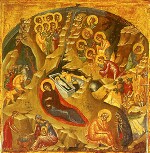 |
Nativity of Jesus the Christ - December 25 The story of the birth of our Savior according to St. Luke begins thus: “It came to pass in those days, that there went out a decree from Caesar Augustus that all the world should be taxed. (And this taxing was first made when Cyrenius was governor of Syria.) And Joseph also went up from Galilee out of the city of Nazareth into Judea, unto the city of David, which is called Bethlehem to be taxed with Mary his espoused wife, who was great with child” (Luke 2:1-15). And though the Christ child was born in a manger in humble circumstance, the joyful tidings of His birth became known to the poor shepherds in a nearby field and to eastern wise men in far off lands. To the shepherds the angel said: “Fear not, for behold, I bring you good tidings of great joy, which shall be to all people. For unto you is born this day in the city of David a Savior, who is Christ the Lord . . . And suddenly there was with the angel a multitude of the heavenly host praising God saying, ‘Glory to God in the highest, and on earth peace, good will toward men’” (Luke 2: 10-11,13-14). In the icon, the Mother of Jesus is shown lying down showing in her posture as being tired which should remind those who pray of the undoubtedly human nature of the Babe. Around the central group - the Divine Child and His Mother - are grouped adoring saints and activities of life all the details of which testify to the Incarnation itself and to its effect upon the whole world. The angels perform a two-fold service. They glorify and they bring good tidings. The man playing the reed-pipe is listening to the angel’s message, thus adding human art - music - to the angel’s choir. In the bottom corner of the icon, two women - midwives - are washing the Child. This shows that the Child is like any other new-born babe and is subject to the natural requirements of human nature. In the opposite corner is Joseph, who is not part of the central group of the Child and His Mother; he is not the father and is thus emphatically separated from this group. Before him under the guise of an old and bent shepherd is the devil tempting him. On the left side of the icon and in the upper corner are the wise men led by a star with gifts. |
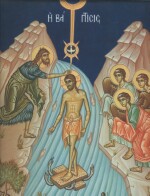 |
Theophany - Baptism of Jesus - January 6 When Christ attained the age of thirty, His time to preach had come, and He appeared to the people for the first time at the Jordan, where John the Forerunner had been heralding the coming of the Messiah. He preached baptism and repentance for the forgiveness of sins. Crowds of people came to John from everywhere, and many began to wonder if he was the promised Messiah, but he told them; “I indeed baptize you with water unto repentance, but He who is coming after me is mightier than I, whose sandals I am not worthy to carry. He will baptize you with the Holy Spirit and fire.” “Then came Jesus from Galilee to John at the Jordan to be baptized by him. And John tried to prevent Him, saying, ‘I need to be baptized by You, and are you coming to me?’ And Jesus answered said to him, ‘Permit it to be so now, for thus it is fitting for us to fulfill all righteousness.’ Then he allowed it. When He had been baptized, Jesus came up immediately from the water. And behold, the heavens were opened to Him, and He saw the Spirit of God descending like a dove and alighting upon Him. And suddenly, a voice came from Heaven, saying, “THIS IS MY BELOVED SON, IN WHOM I AM WELL PLEASED’” (Matt. 3:11-16) In accordance with the Gospel text, in the upper part of the icon, there is a segment of a circle symbolizing the opening heavens. This segment of a circle signifies the presence of God. Above the Savior are rays of light with the Holy Spirit descending in the form of a dove. The choirs of angels take part in the holy ritual. St. John the Forerunner officiates the baptism, placing his right hand on the head of the Savior. |
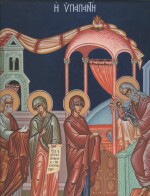 |
Presentation of Christ into the Temple - February 2 According to the Law of Moses, every first born male was to be brought to the temple to be dedicated to God on the fortieth day after birth. At that time a sacrifice of thanksgiving was also to be brought. The Holy Mother of God followed this law, even though she knew that the Child was the Son of God. Thus Joseph and Mary brought the Child Jesus into the temple on the fortieth day along with a humble sacrifice of two young pigeons. Led by the Holy Spirit into the temple on the day that the holy family brought the Child Jesus to fulfill the law, Simeon, a just and devout man who had once been promised by an angel of the Lord that he would not see death before seeing the Messiah born of the Virgin, took the Child into his arms and blessed God by saying: “Lord, now You are letting Your servant depart in peace, according to Your word; for my eyes have seen Your salvation which You have prepared before the face of all peoples, a light to bring revelation to the Gentiles, and the glory of Your people Israel.” (Luke 2:29-32). Anna, the prophetess was also there. She is the one holding the open scroll that signifies her as a prophetess. |
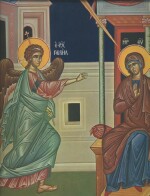 |
The Annunciation to the Virgin Mary - March 25 When Mary became of age, according to Hebrew custom of the time, she could no longer stay at the Temple, but had to either return to her parents or marry. Since Joachim and Anna had died, and Mary had proclaimed her vow of celibacy to the High Priest, it was decided to betroth her to an elderly distant relative who would protect and care for her. She, therefore, went to live in Nazareth with the elderly Joseph, who was a carpenter. Here, according to tradition, while Mary was reading from the prophet Isaiah about the birth of a Messiah to a virgin, the angel Gabriel appeared to her. “And the angel came in to her and said, ‘Hail, you who are highly favored, the Lord is with you; blessed are you among women.’ And when she saw him, she was troubled at his saying and cast about in her mind what manner of salutation this should be. And the angel said to her, ‘fear not, Mary, for you have found favor with God. And behold, you shall conceive in your womb and bring forth a Son, and shall call His name JESUS. He shall be great and shall be called the Son of the Highest; and the Lord God shall give to Him the throne of His father David, and He shall reign over the house of Jacob forever; and his Kingdom there shall be no end.’ Then said Mary to the angel, ‘How shall this be, seeing I know not a man?’ And the angel answered and said unto her, ‘The Holy Spirit shall come upon you, and the power of the Highest shall overshadow you. Therefore also that Holy Being who shall be born of you shall be called the Son of God.’ … And Mary said, ‘Behold the handmaid of the Lord. Be it to me according to your word.” And the angel departed from her” (Luke 1: 28-38). The descending ray from Heaven symbolizes the action of the Holy Spirit. The Mother of Jesus is consenting, shown by the bowing of her head. She presses her right palm against her breast as a gesture of acceptance, which has decided the fate of the world. |
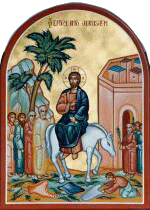 |
Entrance of the Lord into Jerusalem - Palm Sunday (Seven Days Before Pasha) Many in Jerusalem found out that Jesus, the one who had resurrected Lazarus - who had been dead four days - was nearing. “And a very great multitude spread their garments in the way, and others cut down branches from the trees and strewed them in the way. And the multitudes that went before, and followed, cried out, saying ‘Hosanna to the Son of David! Blessed is He that cometh in the name of the Lord! Hosanna in the highest!’ And when He had come into Jerusalem, all the city was moved, saying, ‘Who is this?’ And the multitude said, ‘This is Jesus, the prophet of Nazareth of Galilee.’ And Jesus went into the temple of God, and cast out all those who sold and bought in the temple, and overthrew the tables of the money changers and seats of those who sold doves, and said unto them, ‘It is written, “My house shall be called the house of prayer,” but ye have made it into a den for thieves’. In the next days Jesus Christ taught in the temple. He spent the nights outside the city. The chief priests, the teachers of the Law, and the elders of the people looked for an opportunity to kill Him, but they could not because all the people were around Him listening to His teachings. The icon of the Entry of the Lord into Jerusalem is usually distinguished by a triumphal and festive quality. The group of Apostles and welcoming crowd each welded into one collective figure, with the majestic Savior between them, give the composition a strict equilibrium. Children are welcoming the Savior with palm branches in their hands and the spreading of their garments before Him. For it is the children who welcomed Him with no ulterior motive, with no thought or gain or earthly power. |